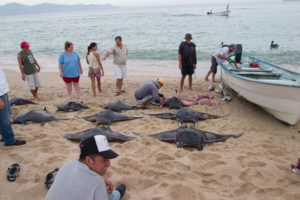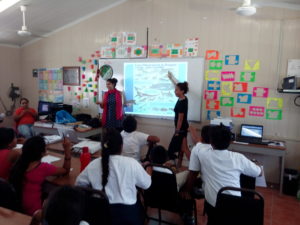Spotted eagle ray research and conservation
The project uses photo-ID to study the spotted eagle rays (SER) that aggregate in large numbers throughout the Mexican Caribbean and are a very important tourism attraction for the SCUBA diving industry in the area. At a local level, we want to understand how SERs use this area and its habitats. At an international level, we want to know if the
 aggregations seen in the Mex Caribbean during winter are moving to areas where they are heavily fished such as Cuba or the Gulf of Mexico; or to other areas where they are protected such as Florida. I was the lead scientist for this project at Blue Core A.C. We worked with Kim Bassos-Hull, from the Mote Marine Laboratory and Dr Juan Carlos Pérez from ECOSUR.
aggregations seen in the Mex Caribbean during winter are moving to areas where they are heavily fished such as Cuba or the Gulf of Mexico; or to other areas where they are protected such as Florida. I was the lead scientist for this project at Blue Core A.C. We worked with Kim Bassos-Hull, from the Mote Marine Laboratory and Dr Juan Carlos Pérez from ECOSUR.
Our paper about spotted eagle rays in the Mexican Caribbean here.
Environmental education on sharks and rays
With Colectividad Razonatura A.C., we did environmental education with kids at primary and secondary schools in remote towns near protected areas where the community can have a major impact on the reefs nearby. The aim of these talks was to share basic information of sharks and rays and their importance in our marine ecosystems and our economy. We aimed to raise awareness within the younger generations that sharks and rays are far more worthy alive than fished and eaten in empanadas.
Fisheries in Baja, Mex
 Sharks and rays project in the Ichthyology lab at CICMAR led by Dr. Felipe Galvan studies biology and fisheries of sharks and rays from fisheries landings. I was part of this lab for a few years participating on field and lab work and did my undergrad thesis on N & C stable isotopes of mobulid rays.
Sharks and rays project in the Ichthyology lab at CICMAR led by Dr. Felipe Galvan studies biology and fisheries of sharks and rays from fisheries landings. I was part of this lab for a few years participating on field and lab work and did my undergrad thesis on N & C stable isotopes of mobulid rays.Tagging mobulas in Mex Caribbean

Assisting Dr. Bonfil with field work in the Mexican Caribbean to tag and sample mobulas for a global study. Using a drone to spot them!
Elasmo fisheries in Gulf of Mex
 The Ichthyology Lab at ECOSUR led by Dr. Juan Carlos Perez uses fisheries landings to understand biology and ecology of sharks and rays.
The Ichthyology Lab at ECOSUR led by Dr. Juan Carlos Perez uses fisheries landings to understand biology and ecology of sharks and rays.

